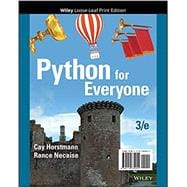Python for Everyone, 3rd Edition is an introduction to programming designed to serve a wide range of student interests and abilities, focused on the essentials, and on effective learning. It is suitable for a first course in programming for computer scientists, engineers, and students in other disciplines. This text requires no prior programming experience and only a modest amount of high school algebra. Objects are used where appropriate in early chapters and students start designing and implementing their own classes in Chapter 9. New to this edition are examples and exercises that focus on various aspects of data science.









